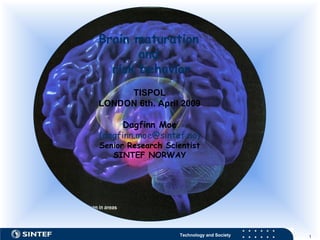Tispol london sintef dmo master
- 1. Brain maturation and risk behavior TISPOL LONDON 6th. April 2009 Dagfinn Moe (dagfinn.moe@sintef.no) Senior Research Scientist SINTEF NORWAY
- 2. Inter- aktion ŌĆØ The truth about the accidentŌĆØ (What ŌĆō How ŌĆō Why) Road conditions Traffic situation Vehicle Neurobiology Sociology Psychology Human Factors
- 3. functional Magnetic Resonance Imaging (fMRI)
- 4. fMRI-group in Bergen 2008 The effect of alcohol on working memory (Gundersen, Gr├╝ner, Specht and Hugdahl-2008) BAC:0,19 BAC: 0,14 Sober BAC: 0,08
- 5. Gogtay, Giedd, et al. (2004) Proc. Natl. Acad. Sci. USA Maturation and learning
- 6. Adolescent brain development can be divided into four processes: (Giedd-2006,Toga-2006 Steinberg-2008) Proliferation Rapid growth of brain matter and new connections Pruning Cutting away of unused or unimportant connections Myelination Insulating of connections to make them faster and more stable Remodeling of the dopamin and oxytocin systems There is a redistribution of dopamine and oxytocin concentration around puberty
- 7. PRUNING AND MYELINATION ŌĆØ building superhighwaysŌĆØ
- 9. Learning Memory Emotion THE LIMBIC SYSTEM ŌĆō EMOTIONAL BRAIN ŌĆØ heaven and hellŌĆØ
- 10. Rate of Maturation adolescent ŌĆ£ emotionalŌĆØ brain ŌĆ£ thinkingŌĆØ brain Galvan et al 2006 Developmental Science
- 11. The battle between the emotional and the thinking brain
- 12. Risk driver profile safety belt drugs-speeding Criminal Men 18-25
- 13. Adolescence is generally a period of increased impulsivity and risk-taking behaviour, but some teens might be especially prone to engage in such behaviours.
Editor's Notes
- #8: These maps are a way to conceptualize a brain that is connection-rich, versus one that has connections pruned due to lack of use. The brain with many and varied connections, like the map on the left, has many ways of approaching goals and solving problems. The brain with fewer, and less strong connections, has limited choices, and it is slower in using those connections.














